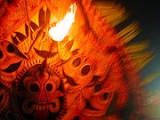
Kummi
Encyclopedia
Kummi is a folk dance
, popular in Tamil Nadu
and Kerala
in India
, danced mostly by Tamil
women in circle
. Dancing may be different. In some places, it is very simple, with rhythmic clapping. In other places dancers imitate various harvesting activities. Kummi often accompany by songs, called "Kummi songs". It is often danced during festival
s. It is also danced by Tamils of Sri Lanka. Kummi songs became a popular addition to kuthiyottam
festivities in modern times.
Kummi is one of the most important and ancient forms of village dances of Tamil Nadu. It originated when there were no musical instruments, with the participants clapping their hands to keep time. This is performed by women; many varieties of Kummi, such as, Poonthatti Kummi, Deepa Kummi, Kulavai Kummi, Kadir Kummi, Mulaipari Kummi, etc. are known. The women stand in a circle and dance clapping their hands rhythmically. One of the women leads the singing with a favourite song while the rest take up the refrain. Each performer renders a new line in turn and the dancing stops when all get tired. This dance is usually performed during temple festivals, Pongal, the harvest festival, family functions like the one to celebrate the coming of age (onset of puberty) of the girl-child.
Folk dance
The term folk dance describes dances that share some or all of the following attributes:*They are dances performed at social functions by people with little or no professional training, often to traditional music or music based on traditional music....
, popular in Tamil Nadu
Tamil Nadu
Tamil Nadu is one of the 28 states of India. Its capital and largest city is Chennai. Tamil Nadu lies in the southernmost part of the Indian Peninsula and is bordered by the union territory of Pondicherry, and the states of Kerala, Karnataka, and Andhra Pradesh...
and Kerala
Kerala
or Keralam is an Indian state located on the Malabar coast of south-west India. It was created on 1 November 1956 by the States Reorganisation Act by combining various Malayalam speaking regions....
in India
India
India , officially the Republic of India , is a country in South Asia. It is the seventh-largest country by geographical area, the second-most populous country with over 1.2 billion people, and the most populous democracy in the world...
, danced mostly by Tamil
Tamil people
Tamil people , also called Tamils or Tamilians, are an ethnic group native to Tamil Nadu, India and the north-eastern region of Sri Lanka. Historic and post 15th century emigrant communities are also found across the world, notably Malaysia, Singapore, Mauritius, South Africa, Australia, Canada,...
women in circle
Circle dance
"Circle dance" is the most common name for a style of traditional dance usually done in a circle without partners to musical accompaniment.-Description:...
. Dancing may be different. In some places, it is very simple, with rhythmic clapping. In other places dancers imitate various harvesting activities. Kummi often accompany by songs, called "Kummi songs". It is often danced during festival
Festival
A festival or gala is an event, usually and ordinarily staged by a local community, which centers on and celebrates some unique aspect of that community and the Festival....
s. It is also danced by Tamils of Sri Lanka. Kummi songs became a popular addition to kuthiyottam
Kuthiyottam
Kuthiyottam is one of the main offering at the Chettikulangara Devi Temple.It is a ritualistic symbolic representation of human bali .KaliGoddess KaliMain article: Kali...
festivities in modern times.
Kummi is one of the most important and ancient forms of village dances of Tamil Nadu. It originated when there were no musical instruments, with the participants clapping their hands to keep time. This is performed by women; many varieties of Kummi, such as, Poonthatti Kummi, Deepa Kummi, Kulavai Kummi, Kadir Kummi, Mulaipari Kummi, etc. are known. The women stand in a circle and dance clapping their hands rhythmically. One of the women leads the singing with a favourite song while the rest take up the refrain. Each performer renders a new line in turn and the dancing stops when all get tired. This dance is usually performed during temple festivals, Pongal, the harvest festival, family functions like the one to celebrate the coming of age (onset of puberty) of the girl-child.

